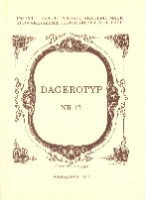Fotografie Jerzego Chojnackiego z powstania warszawskiego 1944 roku na Starym Mieście
The photographs of Jerzy Chojnacki taken during the Warsaw Uprising of 1944
Author(s): Zygmunt Walkowski, Izabela MaliszewskaSubject(s): Photography
Published by: Instytut Sztuki Polskiej Akademii Nauk
Keywords: photography; Polish photography; vintage photography; Chojnacki; Jerzy; sculptor; Warsaw Uprising; Second World War; Old Town; New Town; Warsaw; documentary photography
Summary/Abstract: This article discusses in detail 24 selected pictures taken by Jerzy Chojnacki (1909-1988; ill. 12) in the midst of the Warsaw Uprising. Chojnicki completed his art studies in 1939 and to enter the Polish resistance movement called the Home Army (Armia Krajowa) during the Second World War. When the war ended he became a sculptural artist. In August 1944 this man took pictures in the Old and New Town districts of Warsaw (ill. 13 – a map depicting the neighbourhoods where he took his pictures comes, as well as the precise spot on Freta where he buried the negatives), documenting events from behind the front lines of the Uprising, of which 202, measuring 6 by 9 cm, survived. These pictures represent only part of his works; the rest, which he almost certainly handed over to the Army leaders, perished. Chojnacki never described his pictures in such a way that in order to solve their iconography it would be necessary that each of them might be universally and minutely analysed, drawing attention to all details, and, comparing them with other pictures with the help of specialist as well as recollective literature concerning the Uprising. The article’s two authors divided up the work between themselves: I. Maliszewska worked out Chojnacki’s biogramme together with his Uprising adventures, while Z. Walkowski subjected to analysis, as well as identifying, the pictures, and he it was also who drew the plans marking out the barricades (green) along with the places where nearly every single picture was taken (red dots) and the area taken in by the given camera shot (yellow). He distinguished eight neighbourhoods (ill. 14) in which Chojnacki made pictures. (...) The photographs presented in this article, identified, analysed, illustrated with maps and descriptions of the carnage, now become legible and full of content, transforming themselves from a young sculptor’s amateurish snapshots into a vital historical document of the events and appearance of the Old Town during the Warsaw Uprising. Digitalized and reedited material
Journal: Dagerotyp
- Issue Year: 2003
- Issue No: 12
- Page Range: 20-32
- Page Count: 13
- Language: Polish
- Content File-PDF

